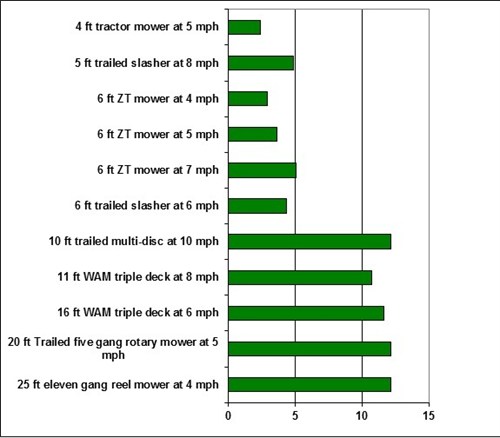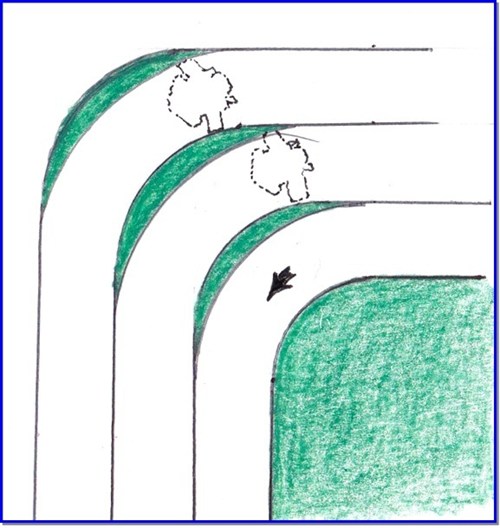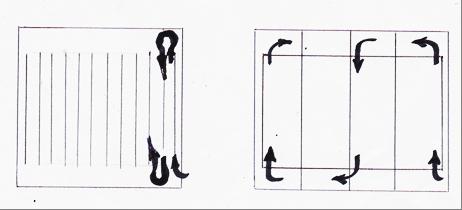Prospective tractor buyers and managers need to assess performance prior to purchase to predict the system’s work capabilities. Dr Graeme Quick offers some tried and true suggestions.
Here are some basic principles for predicting performance or getting the best out of existing machinery.
Before considering the prime mover, make a decision: what will it be used for? What attachments or implements will it be equipped with?
Once the tractor/attachment/implement system is specified, there are several ways to assess its performance.
These are:
Each of these plays into the overall economics of the system and the cost-effectiveness or the return on investment from field operations.
Field Performance
This graph compares the work rate of mowing operations. The bottom axis is field capacity in acres per hour. Increasing speed won’t necessarily increase the overall work rate between different combinations because of turning etc. A zero turn mower will outperform an Ackerman —steered rider any time. Non-productive time makes all the difference. WAM = wide area mower
You can rapidly calculate how big an area you can cover with a simple rule known as: Theoretical Field Capacity (FC)
Acres per hour = implement width (in feet) X speed (in mph) ÷ 8.25. Or, in metric units, Theoretical FC; hectares an hour = implement width (m) X speed (km/h) ÷ 10).
This is the field capacity of any piece of equipment of given width with the tractor operated at the selected speed.
In imperial units, the FC divisor is 8.25, but making it 10 allows for time lost in turns, operator breaks etc; in other words a time loss of about 17.5 per cent short of the theoretical capacity.
According to this rule then a wider and faster machine will have the higher FC — unless there are conditions that would interfere with straightforward work.
Actual field performance falls short if the Theoretical by the Field Efficiency Factor: Actual Field Capacity (AFC) = Theoretical FC X Field Efficiency.
Field efficiency (FE) = Actual Field Capacity X 100 ÷ Theoretical Field Capacity
Some notional FE figures:
Mowing FE = 80 – 90%
Cultivating FE = 68-80%
Spraying FE = 55-80%
Earthmoving FE = 80%
Material Capacity is relevant to such activities as moving dirt, baling hay or harvesting crops:
Tonnes of product per hour = Yield (tonnes/acre) X AFC (acres/hour)
Also, Productivity = Load per cycle X cycles per hour
Finally, Unit Cost, in dollars per tonne = dollars per hour ÷ tonnes per hour
Pattern Performance
Closely connected with Field Efficiency is Pattern Performance or Pattern Efficiency.
There are many ways that you can work over an area. Think for example, of paddock cultivation. Should you go round and round, or up and down?
What about turning at the corners? At least eight patterns are used in broadacre farming and most of them are pertinent to compact equipment operations as well.
Field operating patterns
Certain field operating patterns are more time-efficient than others, particularly those that execute the fastest turns.
There are two main pattern types. Pattern type A or’ circuitous patterns’, sometimes called ‘racecourse’ or ‘round and round’ and pattern type B or ‘working lands’ and ‘headland’ patterns.
Pattern A: ‘Round and Round’
Driving round and round is simple enough, but how about the corners? The two simplest types of turns on a rectangular course are:
- Ninety-degree continuous turns: These are plain no-nonsense turns but they leave crescent-shaped pieces unworked; the size of crescents depends on the turning radius and width of the implement or attachment.
- Loop turns: Doing a loop at each corner on the other hand makes a neat cusp and ‘cuts out’ the corners at each turn so that no further work is needed there. The penalty is turn time that can eat up useful work time, especially in a short or squat field.
There are several other types of fancy turns that are possible but those are more complex and time consuming.
They depend on factors such as whether the attachment is towed, rear- or front-mounted; and whether there is a predetermined operating pattern needed — as there is with a side-mounted sickle bar mower or a plough that throws to one side only.
Turning consumes a lot of otherwise productive time, and the more so the smaller the paddock.
Pattern B: Working Lands and Headland Patterns
Working ‘Lands’ refers to the practice of dividing an area or a field that has straight sides into sub-areas and individually working those sub-areas.
That will inevitably call for space to execute the continuous 180 degree turns at the end of each trip.
Those turn-strips are ‘headlands’ which will need subsequent processing to tidy up.
Headland pattern work is more interesting/challenging for the operator than round and round.
For turf striping a sports field, premeditated headland working does leave a nice pattern; the wider the lands, the greater the pattern efficiency.
There are several variants on working in lands and turn patterns that have their own advantages and drawbacks.
Power Performance
This is measured by the mechanical efficiency of powered mobile equipment to deliver power from the engine flywheel down to where it’s needed — to the ground, or through PTOs or hydraulic outlets.
In reality most tractor work is done on the go, so that brings the focus on traction: how much power can be delivered to the ground? A brief overview of a big topic follows.
Wheeled tractors: If you’re working on rough, undulating ground, like towing a trailed brush hog, slashing weeds or rotavating on the back 40 for example, needs a tractor with ample power to be able to push on over the hills as well as drive the implement.
Where traction (the ability to develop drawbar pull) is concerned, tyre selection and tyre management are important.
Tyres
Tractor tyres are either lugged or non-lugged. The lugs are for traction and should always be mounted with the v-pattern pointing downwards at the front of a traction tyre.
The only exception would be for very long roading, then reversing the tyres will extend lug life.
Tractor drive tyres are designated with an R prefix. Non-driving front tyres are often ribbed to aid steering and are designated by an F prefix, and off-roads by an E prefix.
Tyres have either bias ply or radial ply inside the rubber carcase. The number of ply inside the tyre dictate the load rating and service work the tyre can withstand.
Skid-steer loaders and stake-proof forestry tractors are equipped with tyres with as much as 16-ply.
Radials can be operated at lower tyre pressures, which give better traction and a softer ride, but they cost more.
Tyre traction depends on the weight on the individual tyre and soil conditions. The load the tyre can carry in turn is governed by the tyre pressure and speed; those have certain limits which are usually inscribed on the tyre.
A certain amount of slippage is necessary for any traction and pull; for wheeled tractors on drawbar work that could be around 12 to 15 per cent wheel-slip, but only 3 per cent slip for rubber tracks.
Ballasting the tyres or tractor for optimal drawbar pull and balance is complex; for example, there is a different ballast for road work than for field working.
Frequently, surface compaction and marking of greens are of concern. For those reasons special flotation tyres and tread patterns are available for greens-keeping tractors.
Quality Performance
There are two facets to the tractor systems’ quality performance:
- The job that the attachments do or what sort of finish they leave
- The reliability of the tractor and attachments to complete the job
Mowing finish for example can be measured by the appearance of the turf after passage of the mower — is there any scalping or unevenness of cut? How about striping?
Tractor reliability depends on whether the machine is new or used. For a new machine, initial tractor quality out of the factory.
Reliability factors also include how many hours are on the meter, how the tractor and attachments are used or abused in service and how faithfully service and maintenance are managed in order to keep the machine system operable with minimum downtime.
Breakdowns are inevitable sooner or later. The probability and extent of a breakdown is a combination of many factors — including the operator.
Operator Performance
A professional farmer might manage an operation with considerable skill and knowledge of machine performance.
But with a careless or inexperienced driver on the machine, overall system performance will be low and profitability will suffer.
A manager has certain obligations by law to provide the safest reasonable environment and provide employee training in effective use and safety.
Tractors and machines are dangerous. A long day’s work behind the wheel, the noise and the need to be constantly alert is fatiguing, apart from any physical effort involved.
Modern tractors have sophisticated controls; the more complex, the greater the need for sharpness, knowledge and skill in operation.
There’s a difference between a driver and an operator. Just how skilful an operator will become depends so much on ability, experience, training, motivation, aptitude, health and alertness.
Ergonomics
A comfortable tractor will enable the operator to stay at it for more hours or get more out of the set-up in the day. Ergonomics has to do broadly with:
- Comfort — and the operator’s platform and controls layout
- Lowest reasonable noise and vibration levels
- Facility with the controls
- Operator perceptions (and even peer pressure)
- Work organisation
- Implementing safe work practices.
Look for ergonomically-designed tractor features and use them to operate effectively and safely.
Effective tractor driving skills
Good driving experience will never come from a book. The best this segment can do is to add a few tips to what is already in any quality tractor owner’s manual:
- Always sit in the driver’s seat when starting or working the tractor. Never leave the seat with equipment running
- Don’t be in a rush with tractor work — treat the machine like you would if you were handed a drowsy snake — it can be lethal if mishandled. Watch where you are going at all times. Nowadays with auto-steer, mishaps are known; with power poles that seemingly moved or leaving an operator working a neighbour’s paddocks when he woke up
- Keep the tractor in gear going downhill. Start down in low gear to use the engine as a brake. Don’t attempt to change gears midway down with a conventional gearbox transmission
- If you ever get bogged, back out to prevent back-flipping the tractor
- On geared tractors, engage clutch gradually
- To save fuel, don’t allow a gasoline-powered tractor to stand and idle for prolonged periods. Switch off the engine if lengthy delays are expected
- Avoid letting the fuel tank run dry — this can cause fuel system problems and even require repairs in a tractor (due to crud in the bottom of the tank leading to possible fuel pump damage or blockages)
- Running out of fuel is even more of a problem for diesels, where the injection system needs fuel for lubrication. After running out of fuel, some diesels need the fuel system bled to remove air before the engine can be restarted
- Use implement-to-tractor weight transfer where possible for improved traction
- Avoid prolonged heavy pulling work in the lowest gears — that can shorten tractor transmission life
- Gear up and throttle back for best fuel economy.
From the outset, thoroughly digest the operator’s manual — there is much hard-earned wisdom in there.
Conclusion
Good management involves planning work activities in advance – even down to such details as to how to tackle turns. Planning will pay off and enhance safety.
Each of these performance criteria play into the overall economics of a tractor/attachment/machine system and dictate the cost-effectiveness or profitability of a job.
To maximise field efficiency and work organisation:
- Keep machine width full, and minimise overlap
- Keep the machine in work
- Mimimise non-productive travel
- Turn as little as possible, work parallel with the long sides of a rectangular area, not across the short side
- Match tractor and machine appropriately
- Avoid overloading to the point of stalling or plugging the outfit. That would cause needless delays
- Avoid adjusting, service and repair work during “uptime”
- Handle material as little as possible — absolutely avoid double-handling.
Read System Performance part 2: Power and implements
 |
Dr Graeme Quick is an international expert in farm machinery. Over the past 40 years he has held senior positions at Iowa State University, CSIRO and NSW Department of Agriculture. He’s also a best-selling author. Nowadays he holds various engineering consultanices and, with his wife, lives on acreage in Peachester in south-east Queensland where they grow cabinet timbers and fruit trees. He can be contacted at g.quick@bigpond.com. |
This article was initilaly published in NewFarmMachinery magazine issue 6, February 2014. For the latest farm machinery news, reviews and informational features, subscribe to NewFarmMachinery magazine.







